World Roundup
September/October 2019
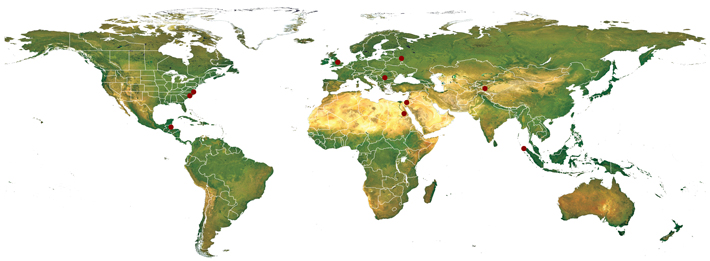

-
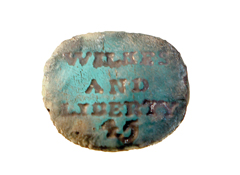 NORTH CAROLINA: A tavern in Brunswick Town that burned down in the 1760s may have been a popular watering hole for rebellious colonials. A small cufflink found among the tavern’s remains was inscribed with the words “Wilkes Liberty 45,” a cryptic rallying cry used by those opposing King George III. The phrase refers to seditious English politician and pamphleteer John Wilkes. In edition no. 45 of his paper, he criticized the English monarch—which got him arrested, but endeared him to American patriots.
NORTH CAROLINA: A tavern in Brunswick Town that burned down in the 1760s may have been a popular watering hole for rebellious colonials. A small cufflink found among the tavern’s remains was inscribed with the words “Wilkes Liberty 45,” a cryptic rallying cry used by those opposing King George III. The phrase refers to seditious English politician and pamphleteer John Wilkes. In edition no. 45 of his paper, he criticized the English monarch—which got him arrested, but endeared him to American patriots. -
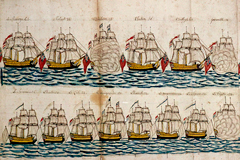 VIRGINIA: Divers exploring the York River identified burned wooden timbers and cannons that may belong to a British ship that sank during the Siege of Yorktown. In this, the Revolutionary War’s decisive battle, George Washington’s army attacked the British by land, while the French navy assaulted them from the sea. More than 40 British ships went down during the onslaught, either from enemy fire or because they were deliberately scuttled by Lord Cornwallis in an attempt to stop a French landing.
VIRGINIA: Divers exploring the York River identified burned wooden timbers and cannons that may belong to a British ship that sank during the Siege of Yorktown. In this, the Revolutionary War’s decisive battle, George Washington’s army attacked the British by land, while the French navy assaulted them from the sea. More than 40 British ships went down during the onslaught, either from enemy fire or because they were deliberately scuttled by Lord Cornwallis in an attempt to stop a French landing. -
 BELIZE: The Maya’s dependence on maize may have ultimately led to their collapse. Isotope analysis of bones from 50 burials at the site of Cahal Pech illustrates how the Maya diet changed between 745 B.C. and A.D. 850. Early communities had a more diverse diet that included maize as well as animals and wild plants. By the 9th century A.D., though, a strong preference for maize, driven by upper-class tastes, led to intensive farming of and overreliance on the crop, leaving it susceptible to drought.
BELIZE: The Maya’s dependence on maize may have ultimately led to their collapse. Isotope analysis of bones from 50 burials at the site of Cahal Pech illustrates how the Maya diet changed between 745 B.C. and A.D. 850. Early communities had a more diverse diet that included maize as well as animals and wild plants. By the 9th century A.D., though, a strong preference for maize, driven by upper-class tastes, led to intensive farming of and overreliance on the crop, leaving it susceptible to drought. -
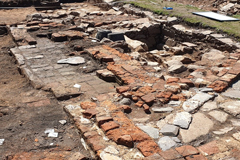 ENGLAND: The stone foundations of an early phase of Lady Jane Grey’s childhood home were uncovered in Bradgate Park, in Leicestershire. The Greys were one of the most prominent English families during the Tudor period and lived in Bradgate House for more than 200 years. Grey famously ruled England as queen for nine days before being deposed—and executed—in 1554 by Henry VIII’s daughter Mary I.
ENGLAND: The stone foundations of an early phase of Lady Jane Grey’s childhood home were uncovered in Bradgate Park, in Leicestershire. The Greys were one of the most prominent English families during the Tudor period and lived in Bradgate House for more than 200 years. Grey famously ruled England as queen for nine days before being deposed—and executed—in 1554 by Henry VIII’s daughter Mary I. -
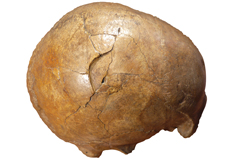 ROMANIA: In 1941, when a 33,000-year-old human skull was discovered in southern Transylvania’s Cioclovina Cave, it was recognized as the remains of one of the earliest modern humans in Europe. New research suggests it is also evidence of a Paleolithic murder. Forensic investigation and experimental simulation concluded that two fractures on the skull were inflicted premortem, and not postmortem as originally thought. The individual appears to have been killed by bluntforce trauma to the head with a club-like object wielded by a left-handed suspect.
ROMANIA: In 1941, when a 33,000-year-old human skull was discovered in southern Transylvania’s Cioclovina Cave, it was recognized as the remains of one of the earliest modern humans in Europe. New research suggests it is also evidence of a Paleolithic murder. Forensic investigation and experimental simulation concluded that two fractures on the skull were inflicted premortem, and not postmortem as originally thought. The individual appears to have been killed by bluntforce trauma to the head with a club-like object wielded by a left-handed suspect. -
 EGYPT: The wild African watermelon has white flesh and is largely inedible due to its bitterness. However, wall paintings from ancient Egyptian tombs depict what appear to be watermelons, which has led experts to speculate that the fruit may have been domesticated in a manner that made it more palatable. Now, DNA sequencing from a watermelon leaf found in a 3,500-year-old tomb in Luxor has shown that two of the melon’s genes were manipulated, causing it to develop red flesh and a sweet taste. This confirms that New Kingdom Egyptians did indeed cultivate watermelons similar to the ones we enjoy today.
EGYPT: The wild African watermelon has white flesh and is largely inedible due to its bitterness. However, wall paintings from ancient Egyptian tombs depict what appear to be watermelons, which has led experts to speculate that the fruit may have been domesticated in a manner that made it more palatable. Now, DNA sequencing from a watermelon leaf found in a 3,500-year-old tomb in Luxor has shown that two of the melon’s genes were manipulated, causing it to develop red flesh and a sweet taste. This confirms that New Kingdom Egyptians did indeed cultivate watermelons similar to the ones we enjoy today. -
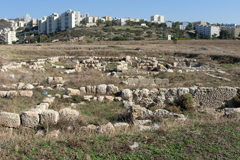 ISRAEL: The walled site of Tel Shikmona has long puzzled archaeologists. Despite its rocky coastline and lack of arable land, a community seemingly thrived there between the 11th and 6th centuries B.C. Recent reevaluation of ceramic material indicates the site housed a facility that produced purple dye, one of the ancient Mediterranean’s most sought-after commodities. The valuable dye was extracted from murex marine snails in a labor-intensive process that is still not fully understood.
ISRAEL: The walled site of Tel Shikmona has long puzzled archaeologists. Despite its rocky coastline and lack of arable land, a community seemingly thrived there between the 11th and 6th centuries B.C. Recent reevaluation of ceramic material indicates the site housed a facility that produced purple dye, one of the ancient Mediterranean’s most sought-after commodities. The valuable dye was extracted from murex marine snails in a labor-intensive process that is still not fully understood. -
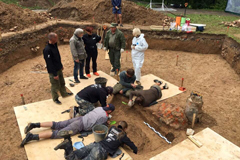 RUSSIA: Some 200 years after Napoleon’s unsuccessful invasion of Russia, residents of Smolensk unknowingly danced on the grave of one of the emperor’s most trusted generals. The body of Charles Étienne Gudin was recently discovered beneath an outdoor dance floor in the city. The skeletal remains were consistent with records showing that Gudin’s left leg was amputated after the 1812 Battle of Valutino. Upon his death, Gudin’s heart was removed, brought back to France, and interred in Paris’ Pere Lachaise cemetery.
RUSSIA: Some 200 years after Napoleon’s unsuccessful invasion of Russia, residents of Smolensk unknowingly danced on the grave of one of the emperor’s most trusted generals. The body of Charles Étienne Gudin was recently discovered beneath an outdoor dance floor in the city. The skeletal remains were consistent with records showing that Gudin’s left leg was amputated after the 1812 Battle of Valutino. Upon his death, Gudin’s heart was removed, brought back to France, and interred in Paris’ Pere Lachaise cemetery. -
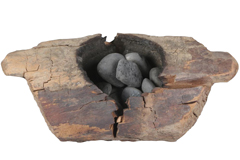 CHINA: Long before it was popularized in the West by the 1960s counterculture, cannabis was an important part of Central Asian rituals. Researchers have detected trace amounts of the drug on several 2,500-year-old wooden braziers from the Jirzankal cemetery in far western China. This is the oldest scientifically verified evidence of cannabis smoking. The samples contained higher levels of psychoactive chemicals than most wild cannabis varieties, suggesting that locals may have cultivated the plant for its mind-altering effects.
CHINA: Long before it was popularized in the West by the 1960s counterculture, cannabis was an important part of Central Asian rituals. Researchers have detected trace amounts of the drug on several 2,500-year-old wooden braziers from the Jirzankal cemetery in far western China. This is the oldest scientifically verified evidence of cannabis smoking. The samples contained higher levels of psychoactive chemicals than most wild cannabis varieties, suggesting that locals may have cultivated the plant for its mind-altering effects. -
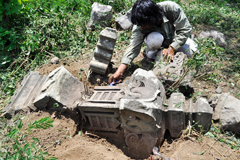 INDONESIA: When the 2004 tsunami hit the northwestern coast of Sumatra, it caused almost unimaginable destruction. It also unearthed evidence that a previous tsunami had struck some 600 years earlier. A survey along 25 miles of coast near Banda Aceh revealed that at least 10 medieval communities once thrived there as part of the maritime Silk Road. A 1394 tsunami destroyed all but one of them. Thousands of recently recorded 15th-century Muslim gravestones suggest that Islamic traders eventually resettled the abandoned coast.
INDONESIA: When the 2004 tsunami hit the northwestern coast of Sumatra, it caused almost unimaginable destruction. It also unearthed evidence that a previous tsunami had struck some 600 years earlier. A survey along 25 miles of coast near Banda Aceh revealed that at least 10 medieval communities once thrived there as part of the maritime Silk Road. A 1394 tsunami destroyed all but one of them. Thousands of recently recorded 15th-century Muslim gravestones suggest that Islamic traders eventually resettled the abandoned coast.
Advertisement
IN THIS ISSUE
From the Trenches
The Case for Clotilda
Off the Grid
A God Goes Shopping
Half in the Bag
Herding Genes in Africa
Bronze Age Palace Surfaces
Upper Paleolithic Cave Life
Scarab From Space
A Catalog of Princes
Sowing the Land
We Are Family
Home on the Plains
Saqqara's Working Stiffs
Inner Beauty
Volcano Viewers
Partially Identified Flying Objects
World Roundup
Egyptian watermelons, a Sumatran tsunami, Siege of Yorktown shipwrecks, and the house of the nine-day queen
Artifact
Just a fleeting impression
Advertisement

Recent Issues
-
 May/June 2024
May/June 2024
-
 March/April 2024
March/April 2024
-
 January/February 2024
January/February 2024
-
 November/December 2023
November/December 2023
-
 September/October 2023
September/October 2023
-
 July/August 2023
July/August 2023
-
 May/June 2023
May/June 2023
-
 March/April 2023
March/April 2023
-
 January/February 2023
January/February 2023
-
 November/December 2022
November/December 2022
-
 September/October 2022
September/October 2022
-
 July/August 2022
July/August 2022
-
 May/June 2022
May/June 2022
-
 March/April 2022
March/April 2022
-
 January/February 2022
January/February 2022
-
 November/December 2021
November/December 2021
-
 September/October 2021
September/October 2021
-
 July/August 2021
July/August 2021
-
 May/June 2021
May/June 2021
-
 March/April 2021
March/April 2021
-
 January/February 2021
January/February 2021
-
 November/December 2020
November/December 2020
-
 September/October 2020
September/October 2020
-
 July/August 2020
July/August 2020
-
 May/June 2020
May/June 2020
-
 March/April 2020
March/April 2020
-
 January/February 2020
January/February 2020
-
 November/December 2019
November/December 2019
-
 September/October 2019
September/October 2019
-
 July/August 2019
July/August 2019
-
 May/June 2019
May/June 2019
-
 March/April 2019
March/April 2019
-
 January/February 2019
January/February 2019
-
 November/December 2018
November/December 2018
-
 September/October 2018
September/October 2018
-
 July/August 2018
July/August 2018
-
 May/June 2018
May/June 2018
-
 March/April 2018
March/April 2018
-
 January/February 2018
January/February 2018
-
 November/December 2017
November/December 2017
-
 September/October 2017
September/October 2017
-
 July/August 2017
July/August 2017
-
 May/June 2017
May/June 2017
-
 March/April 2017
March/April 2017
-
 January/February 2017
January/February 2017
-
 November/December 2016
November/December 2016
-
 September/October 2016
September/October 2016
-
 July/August 2016
July/August 2016
-
 May/June 2016
May/June 2016
-
 March/April 2016
March/April 2016
-
 January/February 2016
January/February 2016
-
 November/December 2015
November/December 2015
-
 September/October 2015
September/October 2015
-
 July/August 2015
July/August 2015
-
 May/June 2015
May/June 2015
-
 March/April 2015
March/April 2015
-
 January/February 2015
January/February 2015
-
 November/December 2014
November/December 2014
-
 September/October 2014
September/October 2014
-
 July/August 2014
July/August 2014
-
 May/June 2014
May/June 2014
-
 March/April 2014
March/April 2014
-
 January/February 2014
January/February 2014
-
 November/December 2013
November/December 2013
-
 September/October 2013
September/October 2013
-
 July/August 2013
July/August 2013
-
 May/June 2013
May/June 2013
-
 March/April 2013
March/April 2013
-
 January/February 2013
January/February 2013
-
 November/December 2012
November/December 2012
-
 Sep/Oct 2012
Sep/Oct 2012
-
 September/October 2012
September/October 2012
-
 July/August 2012
July/August 2012
-
 May/June 2012
May/June 2012
-
 March/April 2012
March/April 2012
-
 January/February 2012
January/February 2012
-
 November/December 2011
November/December 2011
-
 September/October 2011
September/October 2011
-
 July/August 2011
July/August 2011
-
 May/June 2011
May/June 2011
-
 March/April 2011
March/April 2011
-
 January/February 2011
January/February 2011
Advertisement






